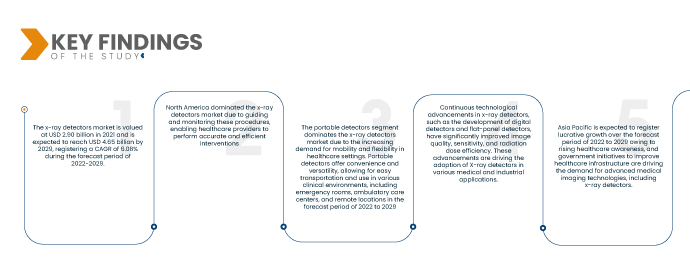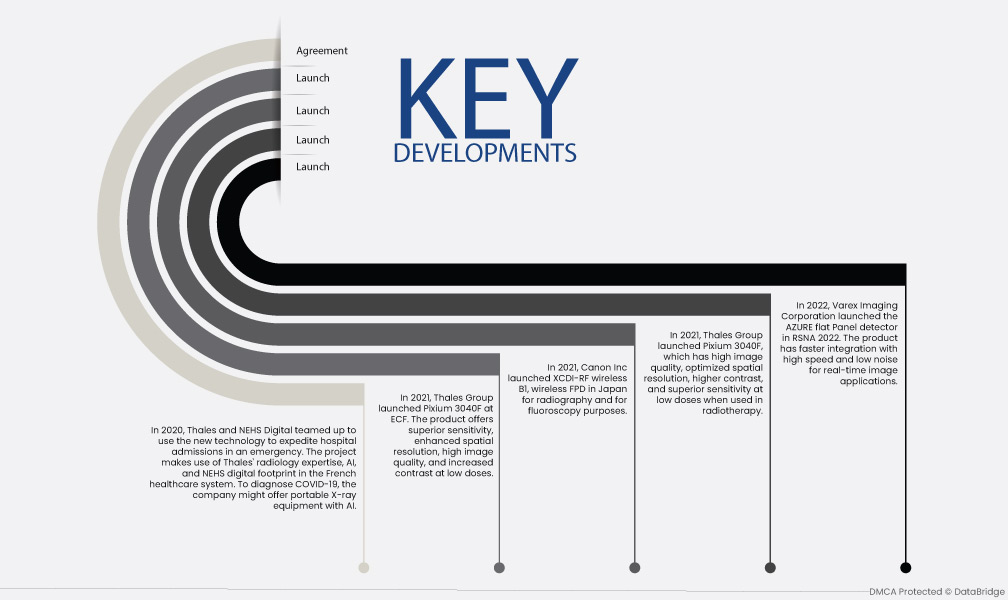The global x-ray detectors market is experiencing significant growth driven by advancements in medical imaging technologies, rising prevalence of chronic diseases, and increasing demand for early and accurate diagnosis. X-ray detectors offer improved image quality, reduced radiation exposure, and enhanced workflow efficiency. The market is witnessing innovations in portable and wireless detectors and integration with artificial intelligence, further fueling the adoption of X-ray detectors across various medical applications.
Access Full Report: https://www.databridgemarketresearch.com/reports/global-x-ray-detectors-market
Data Bridge Market Research analyses that the X-Ray Detectors Market is valued at USD 2.90 billion in 2021 and is expected to reach USD 4.65 billion by 2029, registering a CAGR of 6.08% during the forecast period of 2022-2029. The increasing prevalence of chronic diseases and the rising geriatric population have led to a growing demand for medical imaging procedures. X-ray detectors play a crucial role in medical imaging, enabling accurate diagnosis, disease monitoring, and treatment planning.
Key Findings of the Study
Regulatory mandates for patient safety are expected to drive the market's growth rate
Stringent regulatory mandates for patient safety and radiation dose reduction have necessitated the adoption of advanced X-ray detectors in healthcare settings. These regulations aim to minimize radiation exposure to patients while ensuring high-quality diagnostic images. Advanced X-ray detectors offer improved sensitivity and efficiency, allowing healthcare providers to maintain optimal image quality while adhering to safety protocols. Meeting these regulatory requirements, X-ray detectors contribute to enhanced patient safety and the delivery of accurate and reliable diagnostic results.
Report Scope and Market Segmentation
|
Report Metric
|
Details
|
|
Forecast Period
|
2022 to 2029
|
|
Base Year
|
2021
|
|
Historic Years
|
2020 (Customizable to 2014 - 2019)
|
|
Quantitative Units
|
Revenue in USD Billion, Volumes in Units, Pricing in USD
|
|
Segments Covered
|
Type (Flat Panel Detector, Computed Radiography Detectors, Line Scan Detectors, Charged Coupled Device (CCD) Detectors and Mobile Detectors), Panel Size (Small Area and Large Area), Portability (Fixed Detectors and Portable Detectors), Application (Medical Imaging, Dental Application, Security Application, Veterinary Application and Industrial Application), End User (Hospitals, Diagnostic Laboratories, Original Equipment Manufacturers (OEM'S), Clinics and ICU)
|
|
Countries Covered
|
U.S., Canada and Mexico in North America, Germany, France, U.K., Netherlands, Switzerland, Belgium, Russia, Italy, Spain, Turkey, Rest of Europe in Europe, China, Japan, India, South Korea, Singapore, Malaysia, Australia, Thailand, Indonesia, Philippines, Rest of Asia-Pacific (APAC) in the Asia-Pacific (APAC), Saudi Arabia, U.A.E, South Africa, Egypt, Israel, Rest of Middle East and Africa (MEA) as a part of Middle East and Africa (MEA), Brazil, Argentina and Rest of South America as part of South America.
|
|
Market Players Covered
|
GENERAL ELECTRIC COMPANY (U.S.), TOSHIBA CORPORATION (Japan), Koninklijke Philips N.V. (Netherlands),, Carestream Health. (U.S.), Shenzhen Mindray Bio-Medical Electronics Co., Ltd. (China), Ziehm Imaging GmbH (Germany), Canon Inc. (Japan), FUJIFILM Holdings Corporation (Japan), GMM PFAUDLER. (India), Danaher. (U.S.), PLANMECA OY (Finland), VATECH (India), Villa Sistemi Medicali Spa. (Italy), Midmark Corporation. (U.S.), Apteryx Imaging Inc. (Canada), Varian Medical Systems, Inc. (U.K.), Hamamatsu Photonics K.K. (Japan), KA Imaging (Canada), among others
|
|
Data Points Covered in the Report
|
In addition to the insights on market scenarios such as market value, growth rate, segmentation, geographical coverage, and major players, the market reports curated by the Data Bridge Market Research also include depth expert analysis, patient epidemiology, pipeline analysis, pricing analysis, and regulatory framework.
|
Segment Analysis:
The X-ray detectors market is segmented on the basis of type, panel size, portability, application, and end user.
- On the basis of type, the x-ray detectors market is segmented into flat panel detector, computed radiography detectors, line scan detectors, charged coupled device (CCD) detectors, and mobile detectors. Flat panel detector segment is expected to dominate the type segment of the x-ray detector market with a CAGR of 5.4% in the forecast period of 2022 to 2029 due to over conventional image intensifiers, including better image quality, increased dose efficiency, quicker image acquisition, and compatibility with a range of imaging modalities. FPDs are a preferred option in medical imaging applications such as radiography, fluoroscopy, and mammography because they have improved diagnostic capabilities.
In 2022, Flat panel detector segment is expected to dominate the type segment of the x-ray detector market
In 2022, Flat panel detector segment is expected to dominate the type segment of the x-ray detector market owing to their advantages over traditional image intensifiers, such as higher image quality, improved dose efficiency, faster image acquisition, and compatibility with various imaging modalities. FPDs offer enhanced diagnostic capabilities, making them a preferred choice in medical imaging applications, including radiography, fluoroscopy, and mammography with a CAGR of 5.4%in the forecast period of 2022 to 2029.
- On the basis of panel size, the x-ray detectors market is segmented into small area and large area. The large area panel size segment dominates the x-ray detectors market due to its ability to capture a wider field of view, accommodating a broader range of imaging applications and providing greater flexibility in clinical settings in the forecast period of 2022 to 2029.
- On the basis of portability, the x-ray detectors market is segmented into fixed detectors and portable detectors. The portable detectors segment dominates the X-ray detectors market due to the increasing demand for mobility and flexibility in healthcare settings. Portable detectors offer convenience and versatility, allowing for easy transportation and use in various clinical environments, including emergency rooms, ambulatory care centers, and remote locations in the forecast period of 2022 to 2029.
- On the basis of application, the X-ray detectors market is segmented into Medical Imaging, dental application, security application, veterinary application and industrial application. Medical application segment is expected to dominate the application segment of the x-ray detectors market with a CAGR of 11.0% in the forecast period of 2022 to 2029 due to the main use of X-ra detectors, which is prevalent in healthcare settings, is for imaging and diagnostic procedures.
In 2022, the medical application segment is expected to dominate the application segment of the x-ray detectors market
In 2022, the medical application segment is expected to dominate the application segment of the x-ray detectors market owing to the primary application where x-ray detectors are extensively used for diagnostic purposes and imaging procedures in healthcare settings with a CAGR of 11.0% in the forecast period of 2022 to 2029.
- On the basis of end user, the x-ray detectors market is segmented into hospitals, diagnostic laboratories, original equipment manufacturers (OEM'S), clinics and ICU). Hospitals segment is growing with a CAGR of 5.4% in the forecast period of 2022 to 2029 due to the primary healthcare facilities where x-ray imaging is performed for diagnostic purposes and patient care in the forecast period of 2022 to 2029 .
Major Players
Data Bridge Market Research recognizes the following companies as the major X-ray detectors market players in the x-ray detectors market are Canon Inc. (Japan), FUJIFILM Holdings Corporation (Japan), GMM PFAUDLER. (India), Danaher. (U.S.), PLANMECA OY (Finland), VATECH (India), Villa Sistemi Medicali Spa. (Italy), Midmark Corporation. (U.S.), Apteryx Imaging Inc. (Canada)
Market Development
- In 2022, Varex Imaging Corporation launched the AZURE flat Panel detector in RSNA 2022. The product has faster integration with high speed and low noise for real-time image applications.
- In 2021, Thales Group launched Pixium 3040F, which has high image quality, optimized spatial resolution, higher contrast, and superior sensitivity at low doses when used in radiotherapy.
- In 2021, Canon Inc launched XCDI-RF wireless B1, wireless FPD in Japan for radiography and for fluoroscopy purposes.
- In 2021, Thales Group launched Pixium 3040F at ECF. The product offers superior sensitivity, enhanced spatial resolution, high image quality, and increased contrast at low doses.
- In 2020, Thales and NEHS Digital teamed up to use the new technology to expedite hospital admissions in an emergency. The project makes use of Thales' radiology expertise, AI, and NEHS digital footprint in the French healthcare system. To diagnose COVID-19, the company might offer portable X-ray equipment with AI.
- In 2020, Aero DR NS flat panel detector was introduced by the company. The NS product and the ImagePilot console, an all-in-one solution. For analog or CR users looking to expedite their diagnostics, this economically appealing detector is a great alternative.
Regional Analysis
Geographically, the countries covered in the x-ray detectors market report are U.S., Canada and Mexico in North America, Germany, France, U.K., Netherlands, Switzerland, Belgium, Russia, Italy, Spain, Turkey, Rest of Europe in Europe, China, Japan, India, South Korea, Singapore, Malaysia, Australia, Thailand, Indonesia, Philippines, Rest of Asia-Pacific (APAC) in the Asia-Pacific (APAC), Saudi Arabia, U.A.E, South Africa, Egypt, Israel, Rest of Middle East and Africa (MEA) as a part of Middle East and Africa (MEA), Brazil, Argentina and Rest of South America as part of South America.
As per Data Bridge Market Research analysis:
North America is the dominant region in the x-ray detectors market during the forecast period 2022-2029
North America's dominance in the X-ray detectors market can be attributed to the growing demand for minimally invasive procedures in the region. X-ray detectors play a crucial role in guiding and monitoring these procedures, enabling healthcare providers to perform accurate and efficient interventions. The emphasis on patient comfort, shorter recovery times, and reduced healthcare costs has led to the widespread adoption of minimally invasive procedures, driving the demand for x-ray detectors in North America.
Asia-Pacific is estimated to be the fastest growing region in the x-ray detectors market in the forecast period 2022-2029
Asia-Pacific is poised to experience significant growth in the x-ray detectors market due to increased healthcare sector expenditure in the region. The growing population, rising healthcare awareness, and government initiatives to improve healthcare infrastructure are driving the demand for advanced medical imaging technologies, including x-ray detectors. The increasing investments in healthcare facilities and the expansion of medical imaging centers contribute to the market's growth potential in Asia-Pacific.
For more detailed information about the x-ray detectors market report, click here – https://www.databridgemarketresearch.com/reports/global-x-ray-detectors-market













